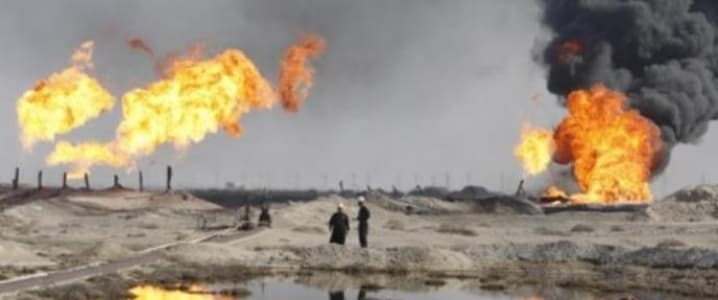Since the Iraqi army drove out Islamic State forces from the oil-rich towns of Shargat and Qayyarah last month, ISIS has lost its ability to produce oil and profit from crude oil sales on the black market—but ISIS is proving to be highly adaptable, and able to find new markets quickly; this time in agriculture.
A quick read of American intelligence on ISIS oil revenues shows this outcome had been anticipated.
The Department of Defense confirmed that oil revenues were no longer the Islamic State’s main source of funding back in February 2015.
“The main source of revenue for them used to be oil,” Pentagon Press Secretary Navy Rear Adm. John Kirby told reporters at the time. “Now we assess that it's no longer the main source of revenue.”
Kirby could not disclose how far the terrorist group’s revenues had fallen since 2014, when ISIS’ oil and gas revenues and cash reserves totaled over $1 billion, according to Daniel Glaser, the Department of Treasury’s assistant secretary for terrorist financing.
As the United States and allied forces ramp up the war against ISIS in the Iraqi city of Mosul over the next few weeks, how has the terrorist organization managed to fund its military and pseudo-government?
After the Islamic State’s control over several Iraqi oilfields peaked last spring, an Al-Jazeera investigation found the list of the terrorist organization’s customers to be “murky.”
The Qatari channel’s documentary in November said ISIS mainly sold its oil to independent traders within Syria and Iraq. Other rebel groups in northern Syria – who themselves fought against ISIS – bought the terrorists’ fuel due to the lack of other options.
But, once ISIS lost control of the Alas and Hamrin oilfields near Tikrit in April, the group’s income declined by an additional $1 million per day. Militants’ salaries were halved, and then halved again, to make up for the lost revenues, along with other austerity measures.
But their newest source of income is agriculture. Specifically, wheat.
A new report by Syria Deeply suggests the terrorist leaders have taken to the wheat trade because the biggest portion of the Fertile Crescent outside of the Syrian government’s control now belongs to ISIS.
A team of researchers at the Barcelona Centre for International Affairs calculated that the total value of 2.45 million tons of wheat from the Crescent equaled the value of the caliphate’s oil revenues in its heyday in 2014 and early 2015.
“While we do not want to deny the importance of other sources, it is a simple fact that ISIS has accidentally, or intentionally, occupied the former breadbaskets of [Iraq and Syria],” Eckart Woertz, one of the researchers looking into the matter, told Syria Deeply. Related: Could An Intense Winter Fuel The Oil Price Rally?
“A lot of the ISIS income initially relied on looting and confiscations. But you can sell a looted archaeological artifact only once. You can get ransom for a hostage only once.”
Global News’ recent story revealed the group’s escalation of bank robberies and kidnappings for ransom to keep the money flowing into its coffers. The robberies - which occurred mainly in Mosul - made up ISIS’ third largest source of income.
Before coalition and Russian airstrikes on oil facilities brought the terrorists’ cash flow to its knees, the Deir Ezzor province in Syria provided 34,000 to 40,000 barrels of oil a day for the group to exploit.
The Qayyara field near Mosul, which now rests in the firm control of the Iraqi military, offered 8,000 barrels a day of heavy crude to make asphalt, according to The Financial Times.
ISIS’ crude sold for as low as $25 a barrel depending on quality, production costs and customer. At times, the group charged rates higher than the international rate - $45 or so - due to the “captive” market of rebel groups active in Syria and Iraq who needed oil to continue operating. Related: Ayatollah Khamenei Accuses OPEC Members Of Waving The Oil Weapon
ADVERTISEMENT
Over the past couple of months, the Iraqi government secured its control over the Fallujah oilfield, as well as Shargat and Qayyarah. But new revelations regarding the group’s agricultural prowess and financial agility could mean a longer and harder fight to regain regional stability.
In the past 18 months, the group has lost 10,000 fighters, a quarter of its territory and unquantifiable amounts of morale. It will take more than funds to keep ISIS alive. Still, picking off cities from ISIS control seems to have kicked in their creative financial problem-solving.
This dangerous game is far from over, and as ISIS appears to move from oil to wheat along the path of least resistance, they are once again targeting a segment that promises keen black market interest.
By Zainab Calcuttawala for Oilprice.com
More Top Reads From Oilprice.com:
- Canadian Oil Is Building A Wall And Mexico Is Paying For It
- Nigerian Oil Under Attack Once Again
- Venezuela Escapes Bankruptcy… But Oil Production Continues To Plunge


















